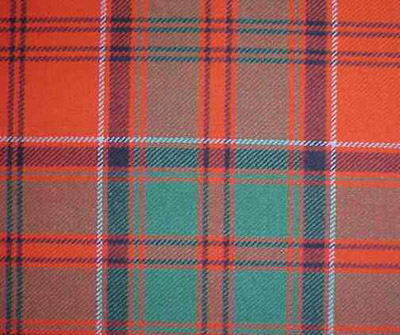Thoughts on the Grant Tartan

The Laird of Grant specified in the well-known edicts of 1704 - 5 that his men were to be all dressed in red and green "broad springed." As "Hank" Grant pointed out in his fine monograph on the Grant tartans, there was no sett specified. However, "Hank" went on to point out that if Grant expected them to be ready in forty-eight hours, they must have had the clothing on hand. The present "Red Grant" tartan was set at least as early as 1819. In the 1819 Key Pattern Book of Wilson's of Bannockburn, a well-known tartan weaving firm of that era, the following handwritten entry appears alongside the pattern known as "New Bruce". "Note: How this pattern was named Bruce cannot be found out. In 1819 Patrick Grant of Redcastle, Ross-shire, head of a great branch of the Clan Grant ordered 200 yards of this Pattern as the tartan of his own Clan."
Ever since the current Lord Strathspey asked his clansmen and women to wear the 1860's sett - and ever since I saw the Locharron Mills version of that sett -- I have been scratching my head (that's how the hair disappeared). The relative widths of the red and green are equal in the so-called "1860's" by Lochcarron -|but it wasn't always so, especially in the middle of the last century
The red "Grant" that Grant of Redcastle purchased had wider green than red stripes: Green 178, Red 156 threads, about fourteen percent larger in the green. The "Grant Kilt" sett in the same book was a "busier" pattern, but green was still larger, Green 76, Red 74 threads. This is about the same ratio as used by some mills today, a 50-50 ratio.
By mid-century, the reverse was true, red was larger, much larger. Illustrations in Keltie's Scottish Highlands: Highland Clans and Regiments (1871) and in James Grant's The Tartans of Scotland (1886), both in our personal collection, clearly show that the red had grown. Red 36 to Green 28. This represents almost thirty percent more Red area than Green.

As late as 1950, the Red still predominated, this time by as much as a third. D. C. Stewart wrote concerning the "Red Grant" in his now classic The Setts of the Scottish Tartans, "The usual design [#70] is ... Red 64, Green 48."
What does all this mean? Since tartan is in `'color blocks" as defined in the "Red Grant" by the azure stripe, for example, theoriginal 1819 sett has almost twice as many threads within the azure square as the red beyond it - i.e. smaller blocks of red. A striking difference at any distance. The 1860's sett is almost the reverse, with more red than green it appears to be "squarer" in design - especially since the four blue stripes in the center are of equal width. When Shirley Grant-Smith and I stand side by side, others often ask, ``We know that Shirley's is a 'Grant' but what tartan is Phil wearing?"
So, how do your garments compare? The "Red Grant" on a targe by our fireplace is Red equals Green. Kilts by different manufacturers are often equal Red and Green Others have mare Red than Green few the reverse, more Green than Red as it was in the tartan purchased by Grant of Redcastle. In any case, the 1860's sets" of the "Red Grant" isn't the way it was in the "real 1860's." The Locharron designers clearly believe that the current version "looks better." But then, it really doesn't matter - as long as they are all red and green "broad springed."
